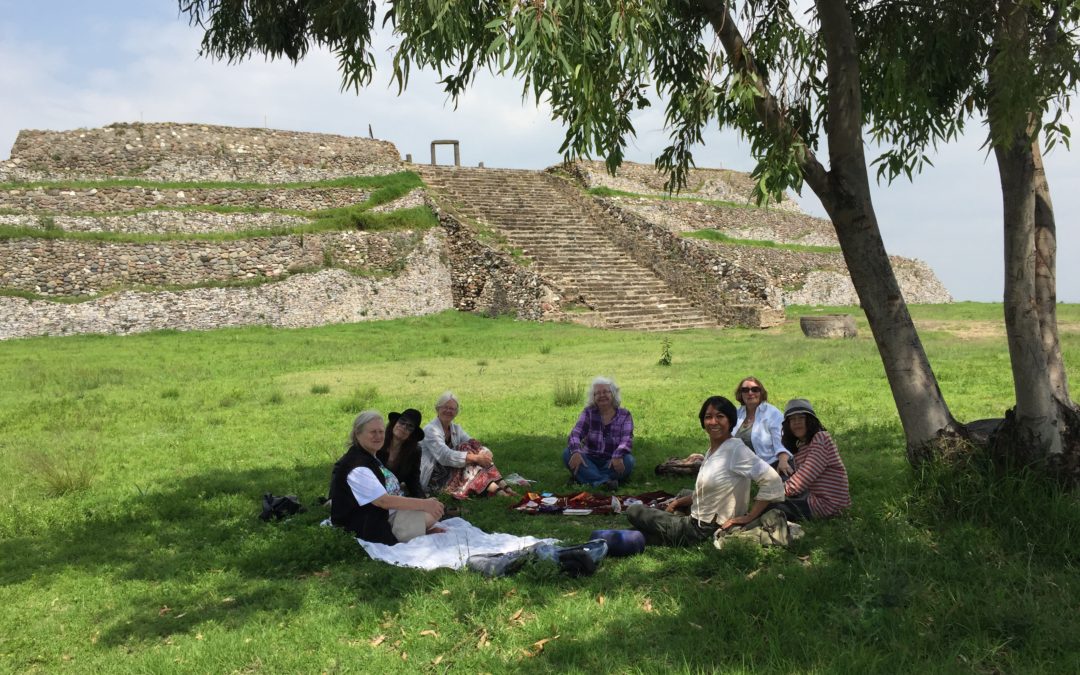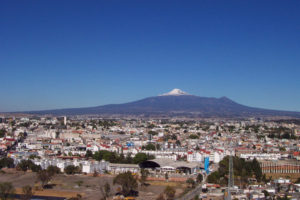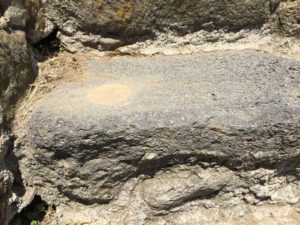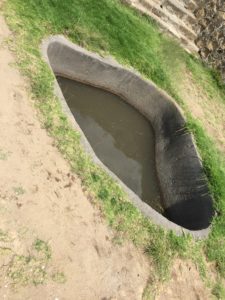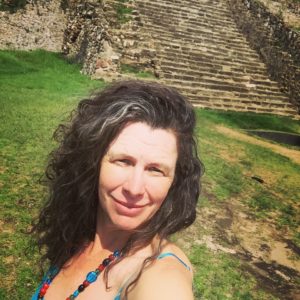The Pyramid of the Flowers at Xochitecatl has a deep resonance with women’s mysteries. It is believed that this site was used as a ceremonial center. Perched atop an extinct volcano, the vista from Pyramid of the Flowers offers 360 degree panoramic views of the entire Puebla-Tlaxcala Valley and three volcanoes: Popocatepetl, Iztaccihuatl, and La Malinche.
The Pyramid of the Flowers faces La Malinche; in fact, the pyramid seems to be a mirror image. The platform of the pyramid base is approximately 144
meters east to west and 110 meters north to south, similar to that of Teotihuacan’s Pyramid of the Moon. Because of the large volume of the pyramid, tons of rocks and boulders would have been brought up from the lower slopes. Most of the volume dates to the Formative era (700 BCE), but some of the construction was performed during the Late Classic (650-900 CE), showing the many centuries of use.
On September 29th, from the summit of the Pyramid of the Flowers, the sun rises directly over La Malinche. This date corresponds to the festival celebrating the Archangel Michael in the town of San Miguel del Milagro, just a few miles to the east of Xochitecatl (read about the celebration here.) For those of us looking for the roots of women’s ceremony and mystery, this seems to point to the idea that this date held significance prior to the coming of Catholicism to the region. And, because of its connection to Pyramid of the Flowers and La Malinche, this day may have been significant to the rituals held there which most definitely centered around women’s mysteries.
The site itself has only one small structure (Pyramid of the Serpent) that might have served as a residence, leading us to believe that the complex was
mostly used for ceremonial reasons, unlike most other sites (Serra Puche 2012:42-46).
In the Mesoamerican Cosmovision, Cihuatlampa, (cihua = women; lamp= place) was the designation for west, one of the four cardinal directions. Cihuatlampa was also the celestial home of the Cihuateteo, women who died in childbirth. The Pyramid of the Flowers faces Cihuatlampa, further showing its connection to women’s ritual.
The stairway of the pyramid is literally built of women’s tools. There are a number of metate’s, stones for grinding corn, used as stairs. There were offerings of female figurines found embedded in the staircases. Nearly 500 spindle whorls were found, further linking this place to women’s culture (Puche 268).
In front of the stairway are two ritual basins, one above ground and one sunk into the ground. Four sculptures were found in the sunken basin: a toad, a mythological serpent with a human face in its open jaws, and two human faces. Toads are a religious symbol for Mesoamericans, possibly relating to the hallucinogenic properties of their secretions. The serpent with the human face could be a reference to Cihuacoatl, the snake-woman. It has been theorized that the two basins were part of child birthing rituals. The image of La Malinche is reflected in the sunken ritual basin.
La Malinche is locally called Matlalceitl, Lady of the Blue Skirt. This name may be connected with Chalchiuhtlicue, the Goddess rivers, closely associated with childbirth and purification (the name “La Malinche” was not given to the volcano until the 1600’s CE). Streams flow from the volcano, and springs with drinkable water surround the base, adding to the idea that the volcano is closely associated with Chalchiuhtlicue.
There were thirty-two burials found near the bottom of the staircase of the Pyramid of the Flowers, mostly females and infants The burials span the entire use of the ceremonial complex, from Formative Era (pre-800 BCE) to the Late Classic (900 CE). Burials were individual and collective, primary and secondary (Puche 269). These burials show the connection of this sacred place to the mysteries of life and death.
Although Xochitecatl’s dedication to a specific deity is still the subject of debate, its geographic location shows that it was a cosmic center of primary importance. This is evidenced by the orientation of the site toward dawn on a particular date, its special relation to La Malinche, and the fact that Pyramid of Flowers is a copy of that mountain itself. Together, these observations reveal a site where ceremonies were performed in which women played the main roles…where other ritual activities, such as baths and offerings, took place. All of these factors point to ceremonies dedicated to the Earth Mother, as personified by the female volcano. (Puche 279)
Xochitecatl holds the sacred energy of thousands of years of ritual dedicated to women’s mysteries. Visit and experience it for yourself!
References:
Mari Carmen Serra Puche, “The Concept of Feminine Places in Mesoamerica: The Case of Xochitécatl, Tlaxcala, Mexico.” In Gender in Pre-Hispanic America, Cecilia F. Klein, editor. Washington DC: Dumbarton Oaks, 2001.
To visit Xochitecatl in person, join Sacred Tours of Mexico for a Women’s Retreat in the Heart of Mexico, Puebla and Cholula November 2017. For more about the sacred side of Mexico, join our Facebook group and sign up for our newsletter.
Award winning writer Anne Key is the co-founder of Sacred Tours of Mexico. She has been traveling and researching in Mexico since the late 1980’s. With a Ph.D. in Women’s Spirituality, Anne brings both her expertise and love to each tour. Her dissertation and articles on Mesoamerican Goddesses are often cited. She is the author of two memoirs (Desert Priestess: a memoir and Burlesque, Yoga, Sex and Love: A Memoir of Life under the Albuquerque Sun) and is a co-founder of Goddess Ink.
